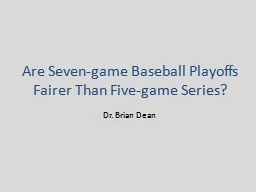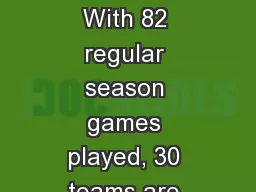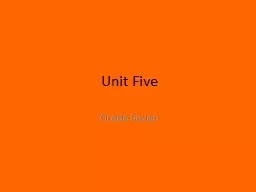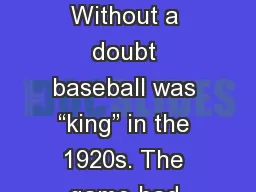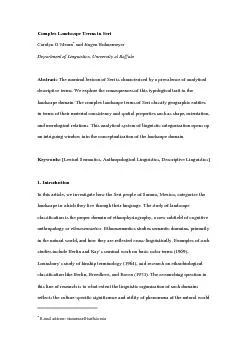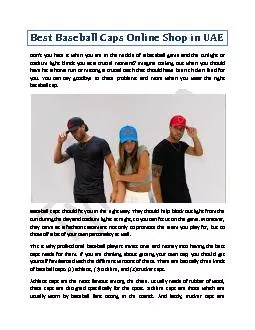PPT-Are Seven-game Baseball Playoffs Fairer Than Five-game Seri
Author : pasty-toler | Published Date : 2016-04-11
Dr Brian Dean The Conventional Wisdom Teams that have earned homefield advantage over the course of a 162game regular season prefer longer sevengame playoff series
Presentation Embed Code
Download Presentation
Download Presentation The PPT/PDF document "Are Seven-game Baseball Playoffs Fairer ..." is the property of its rightful owner. Permission is granted to download and print the materials on this website for personal, non-commercial use only, and to display it on your personal computer provided you do not modify the materials and that you retain all copyright notices contained in the materials. By downloading content from our website, you accept the terms of this agreement.
Are Seven-game Baseball Playoffs Fairer Than Five-game Seri: Transcript
Dr Brian Dean The Conventional Wisdom Teams that have earned homefield advantage over the course of a 162game regular season prefer longer sevengame playoff series to fivegame series feeling that the better team is more likely to win in a longer series. brPage 1br 823 Playoffs 1 Ballstars 800 PM Ballstars 4 Bangers Smashed 900 PM Camel Toes CHAMPS 2 Smack My Pitch Up 700 PM Camel Toes 3 Camel Toes brPage 1br 828 PLAYOFFS 1 No Glove No Love 700 PM No Glove No Love 4 O Dub 800 PM Camel Toes CHAMPS 2 FKAW at SS 600 PM Camel Toes 3 Camel Toes fair | Forum Fairer Handel . (Stand: 2015). . Der Faire Handel in Deutschland. Grundsätze. Wirkungen. Akteure.. 100 % . fair | Forum Fairer . Handel. Inhalt. 100 % fair | Forum Fairer Handel. Fairer Handel – warum. telematics. Safer, Fairer, Simpler. telematics is growing!. We’ve seen our telematics sales increase by 8 times since 2014.. Searches for Black box insurance have increased 4 times.. Based on. data collected by BIBA since 2009.. Opening Day Meeting. April 13th, 2017. Agenda. 2. 1. P.L.A.Y. – Overview. 2. Positive. Coaching Alliance (PCA). 3. Grade Level Specifics. 4. Important Dates. 5. Equipment. 6. P.L.A.Y. Code of Conduct. The . NBA Playoffs . kick off in April as the Golden State Warriors look to defend their title after defeating the Cleveland Cavaliers for the second time in three years. The Western Conference champion Golden State Warriors had bolstered their already impressive roster with the addition of former MVP Kevin Durant, who went on to become just the sixth player in NBA history to score 30 or more points in each game of a finals. Sports always scores with Social with the 2017 NBA Playoffs logging 4.3 million tweets for ESPN and over 750k for the NBA Finals on ESPN . ”. Babe Ruth was born February 6,1895 . in Baltimore, Maryland to parents Kate Schamberger-Ruth and his father George Herman Ruth.. . . Babe’s . first team was the Boston Red . Sox. . H. e . played with them from 1914-1919. He only hit nine home runs while playing with them.. NHL Playoffs . on NBCSN saw 10.2 million interactions for May 2017 with the most social activity during the Washington Capitals at Pittsburgh Penguins game May 10. th. . Playoff coverage spans April 11. . syn. : tale, story, sketch, vignette, yarn. Ex. Many anecdotes relate a humorous incident in someone’s life.. 2. consolidate (v) to combine, unite; to make solid or firm. . syn. : strengthen, firm up, merge. 16 franchises . had been established for at least a decade, the World Series had become institutionalized since its onset in . 1900. . Minor-league . baseball teams at levels from Class AAA to Class D were located in almost every town of more than 10,000 . telematics is growing!. We’ve seen our telematics sales increase by 8 times since 2014.. Searches for Black box insurance have increased 4 times.. Based on. data collected by BIBA since 2009.. Safer, Fairer, Simpler. E-mail address: ckomeara@buffalo.edu and to what extent it reflects universal principles of categorization. Ethnophysiography extends this research to the domain of geographic entities, asking what Looking for Men’s & Women Baseball Caps Online in UAE? Shop caps for online in Dubai & Abu Dhabi at the best prices. Coaches Meeting. Our Sponsor Dick’s Sporting Goods. . . Psa. shop days . 20% off Entire purchase. MARCH 17. th. -20. Th. Agenda. . . Board Introductions. Timeline. Scheduling. Rules and Rule Updates.
Download Document
Here is the link to download the presentation.
"Are Seven-game Baseball Playoffs Fairer Than Five-game Seri"The content belongs to its owner. You may download and print it for personal use, without modification, and keep all copyright notices. By downloading, you agree to these terms.
Related Documents

